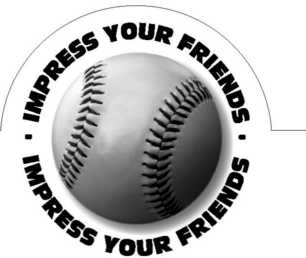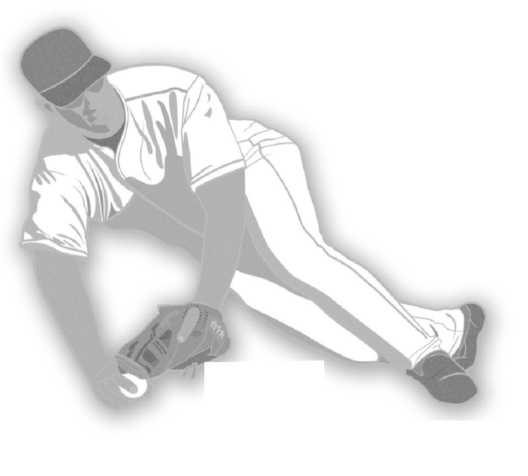The New Ballgame: Understanding Baseball Statistics for the Casual Fan (19 page)
Read The New Ballgame: Understanding Baseball Statistics for the Casual Fan Online
Authors: Glenn Guzzo

The batting stats are the team's composite batting average, home runs,
runs scored, runs batted in, and stolen bases. The pitching stats are wins, saves,
innings pitched, composite ERA, and composite WHIP, also called "ratio."
The genius in the design of the original Rotisserie League is that all of
the crucial stats can be extracted from the common baseball box score. Everyone had access to the numbers; everyone could play.
The rapid growth of fantasy baseball has revolutionized baseball information:
• Because fantasy garners are looking for a competitive edge, they
read voraciously. To meet this demand, magazines, newspapers, web
sites, and numerous books are full of individual player stats, forecasts, scouting reports, and rankings.
• Because fantasy garners only get credit for stats their players achieve,
information on who is playing is precious. Newspapers and web sites now faithfully carry all player-transaction information-who has been
traded, demoted to the minors, or promoted. If a player is benched or
injured, we now almost always hear how long the player is expected to
be out of the lineup and who will replace him, and how the dominoes
will fall in the batting order or the pitching rotation.

Very briefly, here's how to play Rotisserie League Baseball:
Each gamer has a salary cap. It must be distributed to accumulate a
roster that will do well in as many of the league's statistical categories as
possible. Each team will get points depending on how well it ranks vis-avis the other teams in each statistical category.
Your group meets to draft players by bidding your fictional dollars, $280
per team for a league of drafted National League players. You're going
to need twenty-five players, so that's an average just over $11 per man. If
you pay $38 for Albert Pujols (his projected value before the 2006 season
began), you're going to have to surround him with less talent. You might
spend less on pitching, or you might gamble that you can find the lowpriced backup outfielder who is going to be the next surprise star.
Once your team is complete, you monitor each player's performance.
Throughout the season, you make trades or replace unproductive players
with others who are free agents (owned by no other teams). Rotisserie
teams seldom have the luxury of standing pat. A real player gets hurt
and he's worth nothing to you. Another gets traded to a team where he
will have a smaller role and he's no longer worth what you paid for him.
Manipulating your roster resembles playing the stock market: Can you buy
low (before a player gets hot) and sell high (when a player's peak is over)?
Finally, all teams are ranked in each category and points are assigned
accordingly. In a ten-team league, for example, 10 points are given to the
top-ranked team in each category, 9 to the next best, etc. The team with
the most points wins the pennant.
• Because competitive fantasy garners need to be the first to grab hot
young talent before it becomes too familiar and too expensive, baseball fans now have access to more information about minor-league
prospects and the college/high school players expected to be drafted
by major league teams each spring.
• It's now common to see "fantasy-impact" reports with the Internet
site reports on almost every major league game.
The chief byproduct of baseball simulation games and fantasy baseball
is the deeper interest they create in the real sport. Most regular fans are homers-they know much about their hometown team, little about any others.
Simulation and fantasy garners are talent scouts-they research and follow
the fortunes of every major league team and their farm teams. Late season
games between also-ran teams are of great interest to simulation and fantasy
gamers-their drafted players appear in those box scores. Similarly, a late-inning at-bat by, say, Adam Dunn in a 9-1 game is of great interest to the "owners" of Dunn and the pitcher facing him, and of some interest to all the other
franchise owners in the league.
These fans support baseball rabidly. They buy tickets to Spring Training games as well as regular season games. They buy memorabilia, board and video games, and other products that pay royalties to players and leagues.
They speak about the game with passion few other fans can equal.
Fielding Stats Still
Confound Researchers

 here's no dispute that Willie Mays had one of the
here's no dispute that Willie Mays had one of the
strongest, most accurate throwing arms of any outfielder in history. A beer commercial exalting Mays once touted the "hundreds of runners he threw out at home plate." Nice legend, but like most
others, exaggerated.
In his 22 seasons as an outfielder, Mays threw out 195 men-at all
bases combined. He led the National League in outfield assists exactly once.
The true testimony to Mays' throwing skill is not how many men he threw out, but how many he never had the chance to throw out. Soon after Mays'
arrival in the major leagues, opposing baserunners knew not to challenge
him. They tried to take the extra base against Mays only when it was a sure
thing-or so they thought.
Fielding remains a frustrating area of baseball analysis after so much
illumination elsewhere on the diamond. Batting and pitching remain topics
of fertile debate, but the statistics used to evaluate them have mostly been
demystified. So much of what happens on the baseball field is decided by
the pitcher and batter that we have much more data to work with and many
more eager researchers to translate it. By comparison, fielding evaluations are
trapped in a Bermuda Triangle of legend, perception and woefully inadequate
statistics.
For the most part, fielding skill has been measured by errors, total
chances (errors + putouts + assists), and fielding percentage ((putouts + assists) / total chances).
Errors are supposed to tell us how adept (or clumsy) a fielder is-except that they don't. Some fielders make more errors because their other
skills-speed, agility, instincts, desire-get them to far more balls. They are
assigned errors because they get their gloves on balls that other fielders would
wave by, instead of letting them be scored as hits.
Total chances, expressed as total chances per game, is less judgmental
about errors and therefore is supposed to be an improvement, at least to express a defender's range, if not his sure-handedness. But a superior second
baseman's skill might be disguised on a team with a disproportionate amount
of flyball pitchers, or strikeout pitchers. He will also get fewer opportunities-and therefore fewer chances-if his pitching staff is disproportionately left-handed. Lefty pitchers face 75-85% right-handed hitters, whose groundballs go mostly to the shortstop and third baseman. It takes considerably more
analysis to isolate these and similar factors.
Fielding percentage is supposed to account for all this. The extra errors
would be absorbed by the many more chances successfully handled. This
works a little better, but not well enough. A truly bad fielding percentage is
revealing, but a spectacular fielding percentage is not. It is possible for a leadfooted, unambitious outfielder to play a whole season with zero, or very few
errors, while softly hit balls consistently fall in front of him and harder-hit
drives sail to his left and right, and over his head. It's not only possible-it
happens.
Even then, the variables are cloudy. Which of these left- and righthanded pitchers allow fewer balls to be pulled? Ballparks influence fielding
too. Bounces behave differently on turf and grass and on better-maintained
infields or in certain weather conditions. Altitude, humidity, sun and wind direction affect the difficulty in tracking flyballs. And how do we measure how
hard the balls were hit?
The chemistry is murkier still when evaluating throwing skill. For outfielders, the throwing statistic is assists-the men they threw out on the bases.
That's a notoriously deceiving stat-often, players well-known for their weak
arms will be among the league leaders in assists. Opposing runners attempt
the extra base against them much more often, and take riskier chances. The
weak-armed outfielder has many more opportunities for assists than the riflearmed outfielder who freezes baserunners.
Simple or complex, the traditional evaluation systems break down. A
half dozen competing systems to evaluate fielders offer little more than cu riosity value because they so radically disagree with each other. If a fielder
is a savior in one system and a liability in another, both systems may be
suspect. If they also disagree with the circumstantial evidence-daily "web
gem" highlight shows and Gold Glove awards voted on by managers and
coaches-then we either have a bright new light or rubbish. As of now, we
don't know which.
There are a few things that can be said confidently about defense:
• Errors decline and fielding averages go up with every generation of
play.
The various reasons include the size and design of baseball gloves,
the condition of playing surfaces, better coaching/positioning, and
the leniency of modern official scorers. Herman Long, considered a
good shortstop, made 117 errors in 1889. Honus Wagner, considered
one of the greatest shortstops ever, made 49-60 errors every year
from 1903-1910. When shortstop Edgar Renteria made 30 errors in
2005, he was accused of sabotaging the Boston Red Sox' pennant
hopes and was traded after the season for a minor leaguer. Six regular shortstops made fewer than 10 errors in 2006.
• The steady shrinkage in errors means that now the statistical difference between a league leader and a middle-of-the-pack defender
looks miniscule.
Gold Glove winner Mark Teixeira made the fewest errors (4) and
had the highest fielding percentage (997) of all who played at least
115 games at first base in 2006. The worst offender in Teixeira's American League was Toronto's Lyle Overbay, who made all of 9
errors and fielded .994. At shortstop, where the percentages are more
extreme, 15 regulars fielded between.970 and .980.
• The Gold Glove awards consistently reward the spectacularly great
fielders, but sometimes the voting is more suspect than the municipal
elections in Chicago.
Toni Hunter, Andruw Jones and Ichiro Suzuki reliably get the gold,
as did Ozzie Smith and Brooks Robinson. But shaky right fielder
Bobby Abreu got his first Gold Glove in 2005. Rafael Palmeiro got
one in 1999 after playing only 28 games at first base and serving as
the designated hitter in 128 games.
• Even without good defensive statistics, we understand enough about
pitching to know that defense is a distant second to pitching in run
prevention. Even so, defense can make or break big-league careers.
Countless hot prospects have had very short careers after their defense was found wanting, especially at the "up-the-middle" positions (catcher, second base, shortstop, center field). Countless others
have been converted from one of these positions to a corner infield
or outfield spot.
Lost-cause fielders have played in the big leagues. But usually they
haven't played for long unless they have the prodigious power of
Harmon Killebrew or Dick Stuart.
